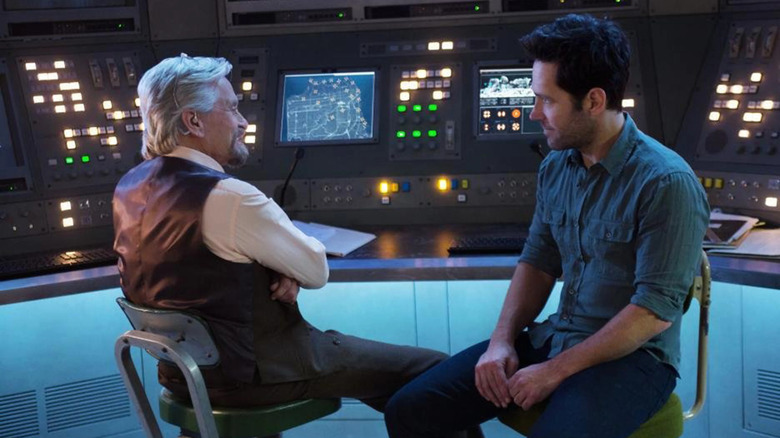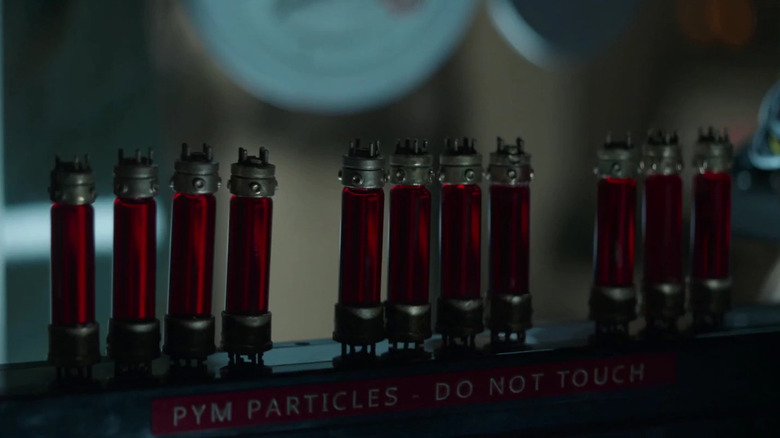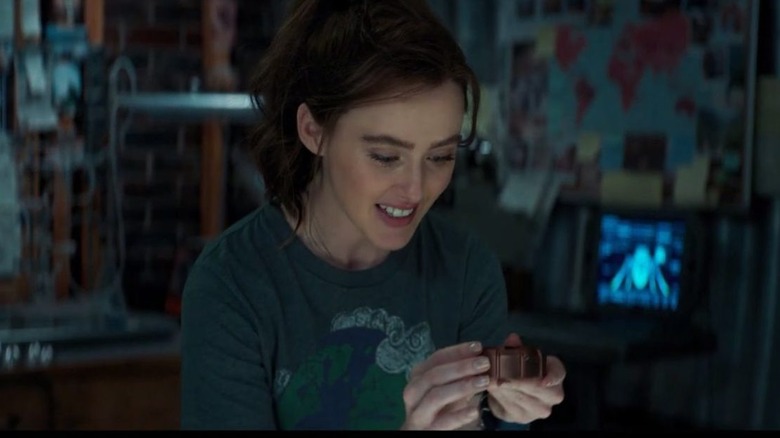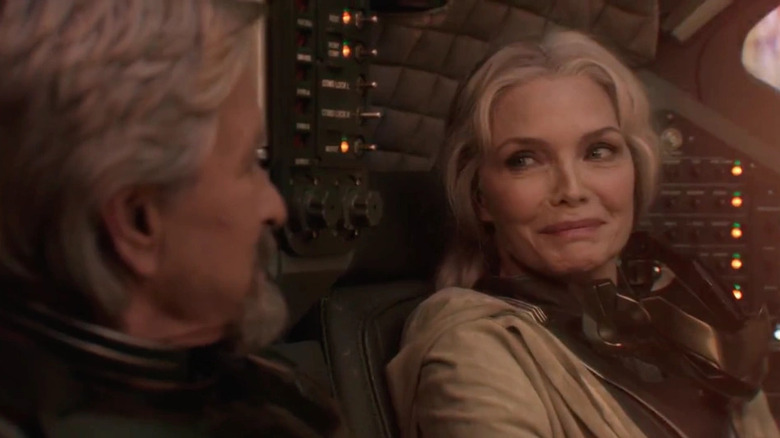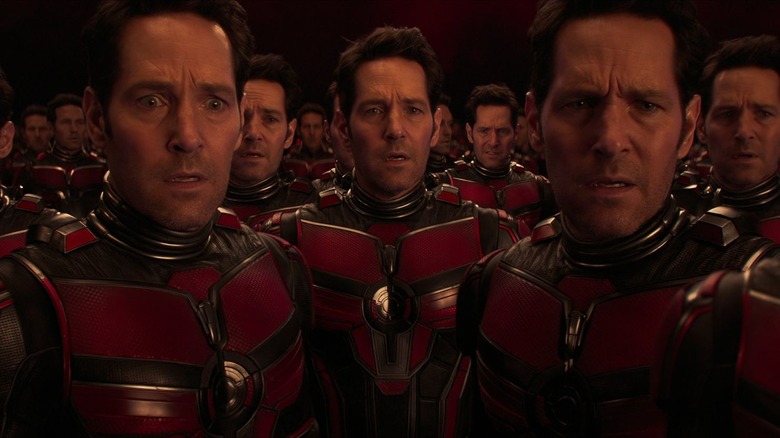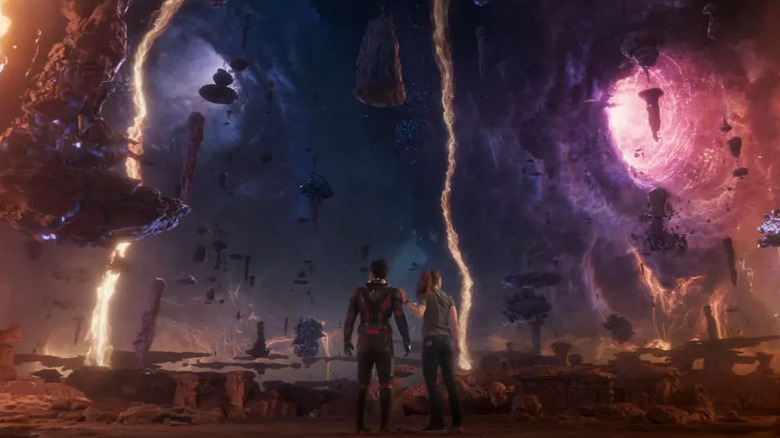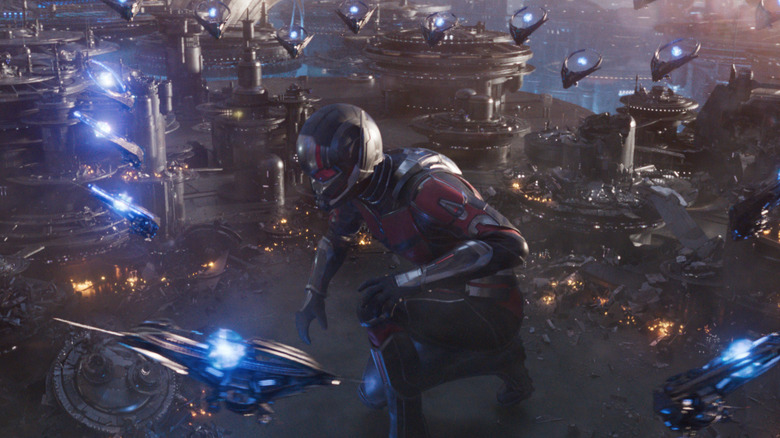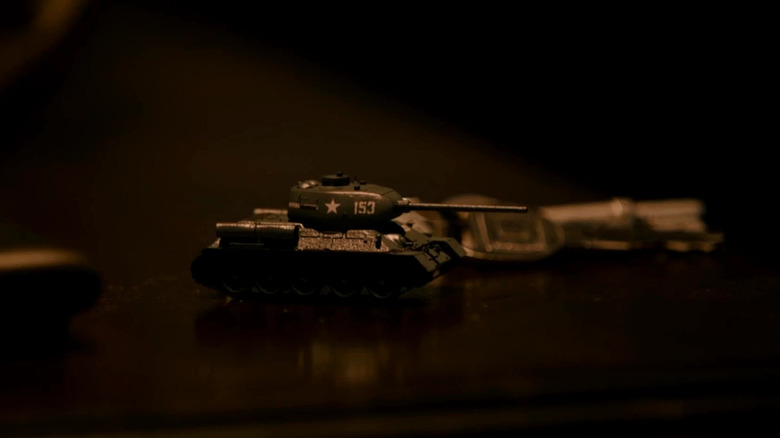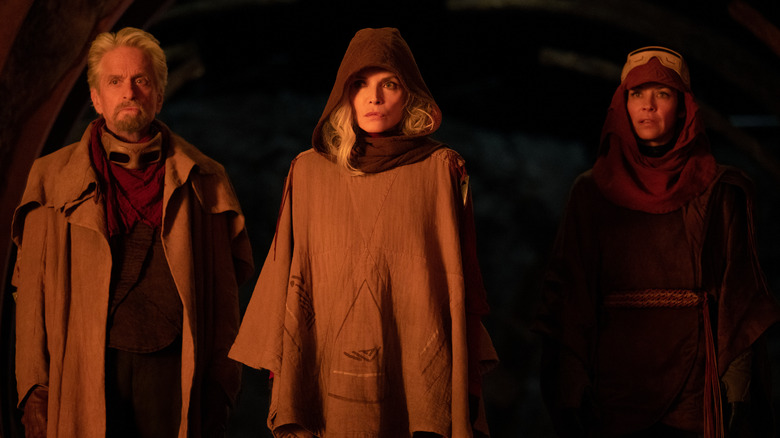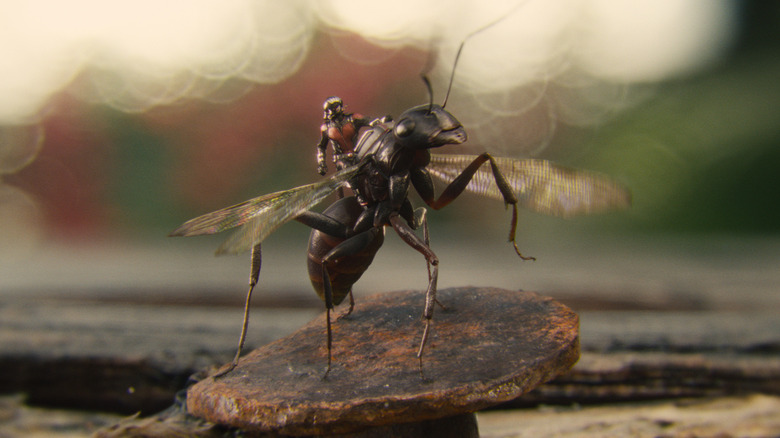5 Times The Ant-Man Films Got The Science Right (And 5 Times They Didn't)
As the Marvel Cinematic Universe has expanded to 31 films, the franchise has increasingly tapped into magic, religion, and science to explain some of its most peculiar plot points as character superpowers. While characters like Doctor Strange and Scarlet Witch harness magic and films like "Eternals" and "Thor: Love and Thunder" lean more into the spiritual side of things, the "Ant-Man" movies, including the newly released "Ant-Man and the Wasp: Quantumania," have gone the other way and used physics to ground their stories. Ironically, the three films that are perhaps the most loaded with technical-sounding terms and whirring, blinking machinery are also some of the most comedic and light-hearted. That contrast — between phrases like atomic relative distance and gags like Yellowjacket getting bug zapped — can make it difficult to determine how seriously we should take some of Hank Pym's claims.
Though the "Ant-Man" trilogy plays fast and loose with science, and with state-of-the-art quantum mechanics especially, the foundation upon which it's built is surprisingly science literate. Things like Pym Particles and Quantum Realm communication systems may be far from becoming a reality, but much of what's currently fiction in the world of "Ant-Man" is rooted in research that's happening right now. It's just been narrativized and pushed into a space that's more fantasy than working theory, as comic book-based stories are wont to do. However, some hallmarks of Hank Pym and Scott Lang's world defy the most basic scientific principles and could never come to fruition. Here's what the "Ant-Man" films understand (and don't) about quantum physics, chemistry, entomology, and more.
Right: strange particles could make science fiction a reality
The foundation of the "Ant-Man" comics and films is Hank Pym's invention of the Pym Particle. It's this scientific achievement that allows Hank and Janet, then Scott, Hope, and Cassie to shrink and grow into their various superhero counterparts. Pym Particles can also be deployed in the form of discs that can be flung at targets (the red ones reduce size while the blue ones enlarge objects). Eventually, Pym Particles make timeline travel possible in "Avengers: Endgame." While Hank's precise invention doesn't exist in our world, there are real-world comps, and such particles are important to the study of theoretical concepts like time travel and multiverses.
Physicist Dr. Jed Macosko explained to Looper that there are two types of particles: ones that make up matter and ones that mediate the forces between it. At that most basic level, Pym Particles — which purport to alter atomic distance and/or mass and density — fall into the latter category. As to their multiversal or time travel capabilities, the MCU isn't that far off. Some of the most common theories about time travel have to do with exotic particles and wormholes. Recently, physicist Pascal Koiran traced a particle through a wormhole (via Livescience), which wasn't thought to be possible before. Particles that behave strangely also play an important role in string theory, the area of scientific research which uses quantum mechanics and general relativity to understand the scope of existence. String theory necessarily supposes that there are multiple dimensions, which gave rise to the idea of the multiverses that have come to dominate sci-fi and superhero stories in popular culture.
Right: quantum computing happening now
Hank didn't just invent Pym Particles; he had to innovate whole labs full of technologies in order to harness their potential. When we catch up with her in "Ant-Man and the Wasp: Quantumania," Cassie Lang is enthusiastically following in Hank's professional footsteps. She's engineered what Hank calls a subatomic basement Hubble telescope that collects, analyzes, and displays data from the Quantum Realm. To Janet's horror, it can also send and receive signals. The Hubble telescope, which mostly takes deep space pictures, is too simple an analogy. It's more like a deep quantum microscope outfitted with something like radar or sonar, not to mention teleportation capabilities. Quantum computing is cutting-edge and lucrative science, though its real-world implications differ from how Hank and Cassie utilize quantum data in the movies.
Along with artificial intelligence, quantum information science is at the forefront of both public investment and privately funded research, with Google, Amazon, Microsoft, and others getting in on the ground floor. Quantum computers use qubits instead of bits. High error rates have been a major obstacle, but one Google appears to have overcome. Professor David Awschalom of the University of Chicago explains that these advancements could lead to meaningfully improved outcomes in human life. Quantum computing devices could detect early-stage disease, making treatment more effective. Quantum probes may be able to predict natural disasters such as earthquakes earlier than our existing technologies could. Scientists have even used quantum computers to teleport information through a wormhole. But current limitations would prevent human teleportation such as M.O.D.O.K. sucking Scott's family into the Quantum Realm via Cassie's signal.
Right: quantum entanglement is real
In "Ant-Man and the Wasp," Hank and Hope get proof of life that Janet is still in the Quantum Realm thanks to an antennae-like device that she planted on Scott while he'd gone subatomic. Afterward, Janet is able to communicate with Hank and Hope through Scott even though she's an entire hidden universe away. In the second and third "Ant-Man" films, this phenomenon is referred to as quantum entanglement, and it's one of the most scientifically grounded ideas in the entire franchise.
Albert Einstein first observed but didn't totally understand or name the concept, which he called "spooky action at a distance." Quantum entanglement was at odds with the established physics of the time, which held, for example, that information couldn't travel faster than the speed of light. A physicist named John Bell refined the idea in 1964, when he theorized that subatomic particles that became linked could affect each other even if they were lightyears apart. This impossible-sounding notion remained unproven until 2015, when three separate groups of researchers were finally able to produce and document Bell's results. Quantum entanglement is so newly understood that its practical applications are still being sorted out. One possible use sort of resembles how Janet and Scott interact: entangled qubits could enable humans to explore and communicate from within black holes.
Right: Scott's probability storm
One of the funnier moments in an otherwise more serious third "Ant-Man" movie comes when Kang forces Scott to use Pym particles to restore the energy core that powers his ship... the one Janet exploded once she realized what a monster he was. M.O.D.O.K. warns Scott that he's about to enter a probability storm and that the longer he stays in its midst, the weirder things will get. Sure enough, Scott begins to encounter infinite versions of himself as he tries to shrink the core, including one that remained employed at Baskin Robbins. At first, Scott's overwhelmed by the chaos, but in the end, all the Ant-Men are able to act as one since they all share the same goal: to save Cassie.
As wacky as the film's depiction of a probability storm is, it has a firm basis in quantum mechanics. The term "probability storm" is made-up jargon for the movie; the real principle at work here is called superposition, which refers to the fact that objects can exist in multiple states at once, and that they only collapse into a single entity again once measured. Schrödinger's cat gets a shout-out in "Ant-Man and the Wasp: Quantumania," too. This famous thought experiment is often used to illustrate or explain the superposition principle, which can be extremely difficult to wrap one's mind around. It asks the thinker to imagine that, because of the tricky probabilities of quantum physics, a cat trapped in a box with radioactive poison could be both alive and dead at the same time. Laurence Fishburne's character, Bill Foster, also delivers an educational monologue about superposition in "Ant-Man and the Wasp."
Right: the Quantum Realm could really look that way
MCU fans get brief glimpses of the Quantum Realm in "Ant-Man" and "Ant-Man and the Wasp," but the subatomic world is the star of the show in "Ant-Man and the Wasp: Quantumania." What director Peyton Reed and production designers have put on screen is as alien as anything humans can imagine, so much so that comparisons to "Star Wars" have abounded (Reed has also directed episodes of "The Mandalorian"). But if we were able to witness life on a quantum scale, some of it might actually look like the Quantum Realm from the "Ant-Man" movies.
According to Space.com, before Scott gets there, he flies amongst particulates (like dust) that look more or less like they would under an electron microscope. Subatomica is also populated by living organisms called tardigrades that look as fascinatingly weird as they do terrifying compared to Hank Pym's super miniature size. Tardigrades are incredibly tiny, incredibly resilient eight-legged beings that have been around for about 600 million years (that's longer than dinosaurs). They measure in at a little less than half a millimeter. That's small, but not quite as small as they're shown to be in the MCU. Still, it's cool that filmmakers drew from real micro-zoology in creating its creatures. Finally, the colorful, CGI-heavy landscapes in the Quantum Realm might seem too other-worldly to be true, but at the quantum level, the dominant experience would be one of hazy, ever-changing waviness in patterns on top of patterns. The mystical backgrounds in "Ant-Man and the Wasp: Quantumania" are an acceptable approximation, especially for a superhero movie.
Wrong: shrinking and growing wouldn't be so easy
For the entire premise of "Ant-Man" to work, audiences have to buy the fact that Hank's technology can allow Scott (or anyone or anything else) to shrink down to the size of a fingernail (or smaller) or grow to the size of a skyscraper. Unfortunately, even if a Pym-like particle could compress the empty space in and between atoms, shrinking and growing at will couldn't work this way in practice, for a variety of pretty lethal reasons. Let's imagine the Pym Particles function as advertised. If Scott really could shrink down, least problematic among the drawbacks would be the loss of anything resembling a human voice. At that size, the frequency of his speech would come out in imperceptible squeaks. He'd also probably starve to death almost immediately, as his metabolism would increase to the point where he'd have to constantly consume food just to maintain his body temperature.
From there, Scott would be vulnerable to forces regular-sized humans take for granted such as sneezes and light winds. We'll get to whether or not Scott's mass would be preserved in a moment, but if it was, poor Scott would be crushed under his own collapsing weight into something that would look an awful lot like the fleshy-colored goo that's left over anytime Darren Cross kills something with his not-quite-perfected shrinking ray gun. Similar problems would arise whenever Scott goes giant (his bones wouldn't support his size, breathing would be an issue, etc.), but the "Ant-Man" films barely mention the fictional science of those blue Pym Particles.
Wrong: that's not how mass works
One of the most fun things about the "Ant-Man" trilogy is the tendency for everyday objects, like Hello Kitty Pez dispensers and personal pizzas, to unexpectedly increase and decrease in size. Hank often makes use of Pym Particles to easily transport large cargo, especially when he and Hope are on the run from nefarious pursuers or the law. He shrinks his lab and his house, and he carries around a Hot Wheels rally case of what appear to be miniature die-cast vehicles, which he and Hope can restore to their normal human scale whenever necessary. It's a convenient application of Hank's research. There's just one problem. That keychain that looks like a tank and is actually a real tank shrunken down with red Pym Particles? According to the immutable laws of our universe, it would still weigh as much as a real tank, even when it fit in Hank's pocket.
The films' explanation of Pym Particles is basically that they compress the empty space between atoms and molecules, leaving mass (or their amount of matter) intact. There's some on-screen evidence to support this. For example, when ant-sized Scott falls and breaks a tile, he does so with the force of a full-sized human. That Scott, Hope, and Cassie's kicks and punches pack regular human force when they've shrunken down in their suits indicates that mass has been retained, too. But if that's so, the mass of those toy cars would render the Hot Wheels case impossible to carry. These inconsistencies are pretty glaring, but they're a necessary flaw in order for the "Ant-Man" trilogy's whole schtick to work.
Wrong: the Quantum Realm isn't a separate reality
This one's a case of art and science imitating each other in real time, though an important detail seems to have gotten lost in translation. Quantum mechanics is still an emerging science with experimental physicists making discoveries concurrent with the rollout of the "Ant-Man" movies. One of the experts who consulted on the franchise, Dr. Spiros Michalakis (a mathematical physicist at Caltech), is the person who actually coined the term Quantum Realm. Michalakis' contributions have heavily influenced the MCU (he was also an advisor on "Captain Marvel"), which took the idea of a seemingly more scientifically supported microverse — which was what the realm was called in the comics — and ran with it.
Janet describes the Quantum Realm as a secret universe underneath their own. That's a slight mischaracterization of what the Quantum Realm actually implies. Though Michalakis calls it "a place of infinite possibility, an alternative universe where the laws of physics and the forces of nature as we know them haven't crystallized," fellow physicist Chris Ferrie points out to Geekwire that the Quantum Realm isn't a separate reality from ours. In other words, it isn't a place in another dimension to which anyone could travel. It exists within our world; it's just that its defining features are that it's really small and it behaves differently than the laws of classical physics. Ferrie suggests that a better way to think of the Quantum Realm is as a second window through which to see and understand reality.
Wrong: the entemology is hit and miss
Besides the Pym Particle-powered ability to shrink and grow, the "Ant-Man" franchise is probably best known for, well, ants. Hank uses the insects to do everything from fetch sugar for hot drinks to defeat Kang the Conqueror. The films get some things about ants right. They're accurate in their references to and depictions of different species of ants, like bullet ants and carpenter ants, including how they look and move. But even so, avoidable mistakes were made in the ant-related research. For example, that the vast majority of ants are female is something that could've easily been fact-checked.
Leaning harder into the sci-fi, the first "Ant-Man" film makes the wild claim that Hank Pym can control his ants' minds by using electromagnetic waves to stimulate the olfactory nerve center in their brains. Supposedly, this mimics naturally occurring pheromones that would motivate the ants. Electromagnetic waves, olfactory nerves, and pheromones are all real things, and ants really do communicate in roughly this way, but suffice it to say these elements haven't been combined into any actionable form of mind control, ant or otherwise. "Ant-Man and the Wasp: Quantumania" actually gets closer to the truth once its ant colony ends up in another dimension and evolves into a super-intelligent socialist society. Ants aren't an army looking to be led by an authoritarian. They have a queen, but they're generally communal. The only problem with their evolution in "Ant-Man 3" is that such dramatic changes would probably take millions as opposed to thousands of years, as is the case with the time-warped ants in the film.
Wrong: Ghost's condition is pure fiction
The villain in "Ant-Man" — Hank Pym's former protégé Darren Cross — is fairly unambiguously corrupt and power-hungry, although he does get a last-minute redemption as M.O.D.O.K. at the end of "Ant-Man and the Wasp: Quantumania." But the big bad in "Ant-Man and the Wasp" is a much more sympathetic character. Ghost (or Ava Starr) is the daughter of one of Hank's associates. His experimentation with quantum tunneling got him killed and exposed a young Ava to so much quantum energy that she became afflicted with a condition that the movie calls molecular disequilibrium. As Ava herself puts it, every cell in her body was torn apart that day and they're all continually being stitched back together. This gives her the ability to do something known as quantum phasing. The practical benefit (for the purposes of the story) is that she can disappear and reappear at will when wearing a specialized super suit and she can pass through solid matter as her cells are constantly breaking down and rearranging, which earns her the nickname Scott gives her. The impractical side effect (and why she's a tragic villain): she's always in pain and her condition is terminal.
Quantum tunneling and quantum phasing are, like superposition and quantum entanglement, both real scientific concepts. However, they're used only superficially in the backstory of Ghost. Molecular disequilibrium is a made-up affliction, and those terms belong more to the discipline of chemistry than physics anyway. In real life, even if what happened to Ava was plausible (and it's not), the damage to her cells would've killed her immediately.
